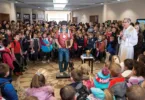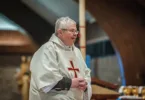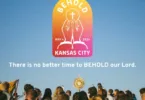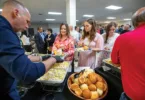by Joe Bollig
joe.bollig@theleaven.org
KANSAS CITY, Kan. — If St.
Paul preached to the Athenians at the Areopagus today, would he also send out tweets?
Probably. St. Paul was a savvy communicator.
Back in the day, the place to go was the Areopagus. Today, the cutting edge of communications is the new media.
More than 100 people involved in church ministry gathered at Savior Pastoral Center in Kansas City, Kan., on June 19 in search of that savvy at the daylong Digital Church Conference, sponsored by the archdiocesan office of evangelization.
The purpose of the event was two- fold: First, to teach conference goers how the tools of the new media work; and second, how to use them for the new evangelization.
Conference speakers included Brandon Vogt, a prominent Catholic blogger and content director for Father Robert Barron’s Word on Fire Catholic Ministries; Josh Simmons, founder and CEO of eCatholic website development; and Matt Warner, social media expert and founder of FlockNote.com.
In his introductory talk about the new media and new evangelization, Vogt talked about the revolutionary impact of social media use via the Internet and wireless technology.
“The Internet meant that anyone could share their story quickly, easily and cheaply,” said Vogt.
Ever heard of the South Korean pop song and video “Gangnam Style”? Since 2012 is has been seen by 1.3 billion people.
And that’s not all:
- Every minute, 80 hours of new video is uploaded to YouTube — in one month, more video is added to You- Tube than by CBS, ABC, NBC and Fox have done in their entire existence.
- Facebook is the world’s most popular website and the world’s largest social network. Every day, people ex- change more than 400 million pieces of content.
- Every day, more than 300 million unique tweets are sent through Twitter. • Last year, Americans sent and received 8 trillion text messages.
“The question for the church, and therefore for all of us in this room, is: How can we tell our story in fresh, creative ways?” he said. “How can we ensure that our message resonates — not just from the rooftops, but from the laptops? How can we ensure our message gets in bold print and screens? How can we proclaim the word made ‘fresh’? That’s the whole point of this conference.”
One of Simmons’ presentations was: “How to Create a Website That Will Transform Your Ministry.”
He said Web creators and managers must begin with the important question of “why”—why is a website needed? This speaks to purpose.
First impressions are import- ant, so it is vital that a website be attractive to entice people to pause there, he said. The content must be fresh and relevant. Information must be easy to find, and websites must be intuitive for the user.
Both the content and design of the page must be dynamic and engaging, encouraging people to get involved, said Simmons. Also, the site must be social — allow for a give-and- take dialogue. It must take into account the multiplicity of devices used, and so must not be browser dependent.
Warner gave presentations on “How to Turn Your Web Presence into a Social Network,” and “Connecting with Your Flock.”
The scarcest commodity is attention, said Warner. When you get it, you have to be wise about using it.
Getting attention is only the first step. The second is to earn the trust of members, and a good place to start is asking: “Why are we saying this?” “What are we trying to say?” and “What goal are we trying to achieve?”
Do not overwhelm people with information, but cut down content to what people want and need, he said. Give your best information.
“Right now, people are getting nothing because we’re trying to say too much,” said Warner.
Websites have evolved away from Web1.0 and are now at Web2.0— which is faster, more mobile (thanks to devices with a variety of formats) and ties into a variety of social networking tools.
“Each one of those formats is used differently,” said Warner. “So we should say different things in different ways, and we should interact in different ways on those things.”
Your website should tell your stories, and these stories inspire people to be a part of your ministry.
“That’s the work of the church in so many different ways — how God is working in our lives, said Warner. “And we have to find ways share that story with them.
“And now, we have all of these powerful means in our pockets and on our desks to tell that story and spread it around like we’ve never been able to do.”
“If we get this right, all those other things become ways that magnify in [what] we never thought that would happen,” he added.






